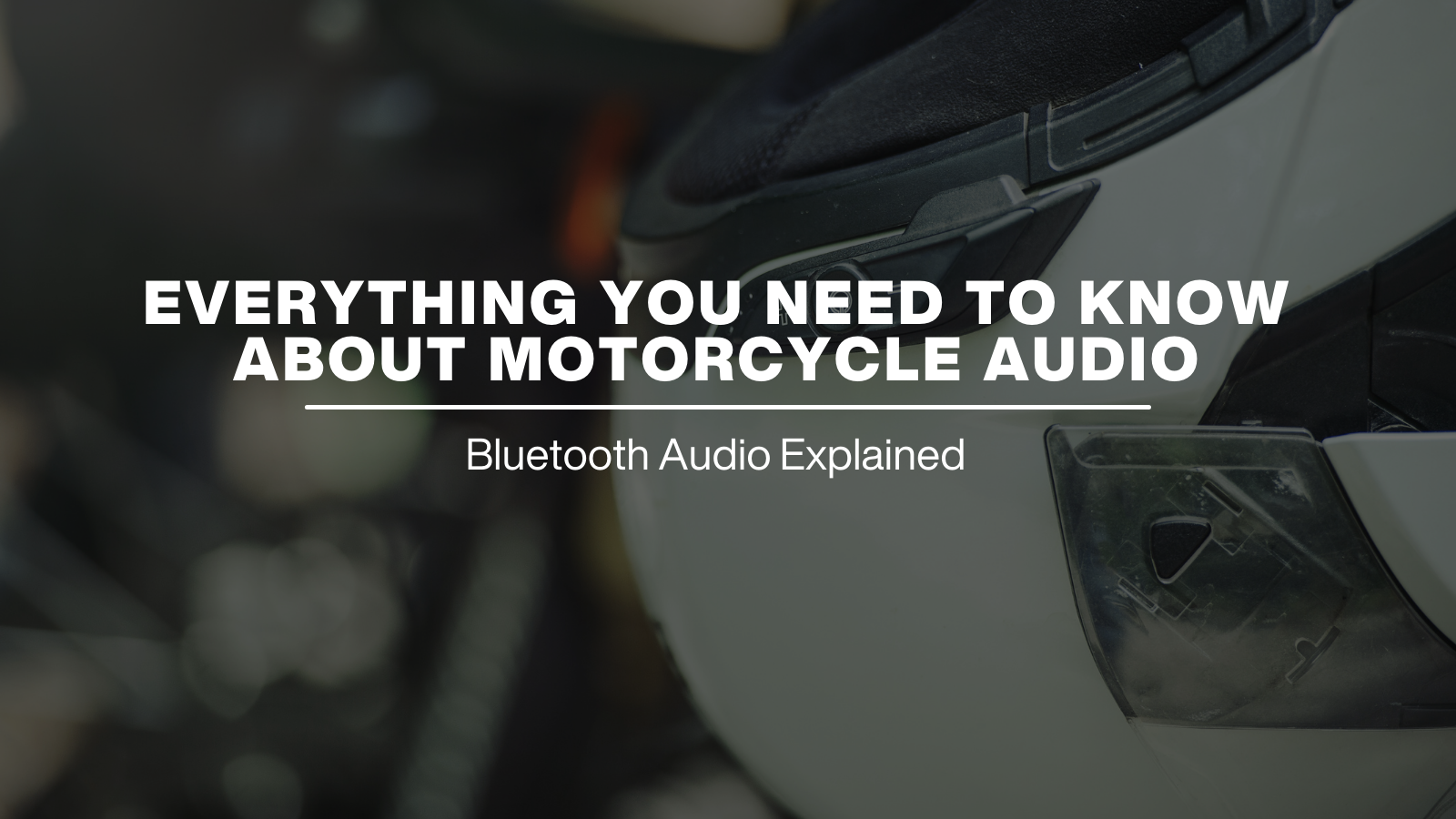by Gabe Ets-Hokin
Screens and headphones. It seems everybody is absorbed in electronic media 24/7. Screens are everywhere—on our wrists, in the kitchen, at work, even in the bathroom. We wear our earbuds, AirPods and giant DJ-headphones, pouring podcasts, music and phone calls into our earholes whenever we're out walking, working out or even at work.
The best way to escape? Get on a motorcycle. Unless you don't want to escape the constant stream of ether. If that's the case, is there a way to wire up your motorcycling experience for electronic media?
Of course there is! This is America, 2021. And we're going to tell you some basic stuff about what motorcycle audio solutions are out there, what we like to use and how to get the best out of this very useful tech. But first...
Can you handle it?
Distracted driving is a leading cause of crashes. In fact, the CDC says about 3,000 people die and 400,000 are injured every year because of distracted driving. We can't say how many were motorcyclists, but we can say being distracted while riding a motorcycle is a really good way to crash one. And nothing is more distracting than electronic media!
That's why even though we have smartphone mounts on our personal motorcycles, we strictly use them for navigation...and sometimes think that maybe isn't a good idea. A purpose-built motorcycle GPS unit may be a better choice, as it's easier to see and operate in motorcycle gear, and it doesn't issue a steady stream of distracting notifications like your smartphone. Sure, you can ignore them...or can you?

Distracted driving is a leading cause of crashes.
Big tech companies have huge teams of very smart people with PhDs trying to figure out how to get your attention. They just want to sell you crap and mine your data, not kill you...but they don't know that distracting you, even for a second, can cost you your life. We think the best place for your smartphone is in your pocket. Plus, most mounts transmit vibration to your delicate little friend, which could damage it.
Bluetooth Headsets
This will not be a Bluetooth (BT) headset buying guide. There are too many choices on the market, many of them good ones. But we can tell you what to look for and what kinds of features you'll find.
Almost all our experience is with the two leading brands, Cardo (which makes the Scala Rider series of BT headsets) and Sena. Both companies make very comparable products—we recommend you start with them.

Typical Bluetooth headset kit. Product shown is by Sena.
BT headsets have many uses, but there are four main ones. They're designed to to pair with your smartphone or some other Bluetooth-enabled device like a GPS unit, tablet, laptop or your motorcycle's entertainment system (Honda, Harley-Davidson, and others offer this).
In this capacity, they “stream” whatever media is coming from the device and allow you to pause, stop, fast-forward, and skip tracks. With your phone, you can take calls, make calls with a speed-dialing function and give commands to Siri or Google's digital assistant.
The Bluetooth functionality also works as a short-range intercom (about 30 feet) with a paired BT headset and, if it's equipped with radio, it can be used as a long-range communicator that can reach other riders a mile or more away. Lastly, most Bluetooth headsets have an FM radio, which is great for local traffic and weather info while riding.
There are two types of Bluetooth headsets. The first kind attaches to your helmet. It can either be a universal fit or one designed for your specific helmet, but either way, everything you need to set it up should come in the box. The control box attaches to the outside of the helmet and is connected to speakers and a microphone.
These kits are great because you can move them from helmet to helmet if you use more than one lid, or replace your old bucket if it’s damaged or obsolete. Plus, they usually have both a stick-on and boom-style mic so it can be used with full-face, modular or open-faced lids.
The second type of Bluetooth headset is a complete system pre-installed in a helmet. These are very convenient and tend to work great right away. Pre-installed BT helmets are great, but if the helmet ages out or is damaged, the BT system goes into the trash with the rest of the lid--sort of wasteful!

Headphones
'Why spend all that dough on a Bluetooth headset?' you might ask. 'Why not just wear your regular headphones or earbuds under your helmet?' Well, you could...but it's not a good solution.
Traditional headphones might work at very low speeds, but once you get above a city-traffic pace, you won't hear much. Not to mention, they're hard to get under a full-face helmet. This is why a designed-for-motorcycle-use BT headset may be the best solution for actually hearing anything at real motorcycling speeds. Noise in decibels (dB) increases exponentially with speed, which is why at more than 40 or 50 mph, you'll need a way to protect your hearing from road noise without blocking out the sound you want to hear from the Bluetooth headset.
Enjoy the ride without the risk
Ear plugs are foam, silicone or other materials that attenuate (turn down) the noise entering your eardrums through your ear canals. Obviously, we're partial to EarPeace MOTO PRO's patented Contour Ear Plug™ design, which is fitted with a removable filter to adjust to your intended use and desired dB level.
One key advantage of EarPeace hearing protection is its compatibility with Bluetooth headset. One thing we've noticed with foam and other silicone plugs is the Sena and ScalaRider headsets just aren't loud enough to really enjoy music, phone calls or spoken word at higher speeds. Other plugs just block out too much sound.
New EarPeace MOTO PRO ear plugs are designed to fit under your helmet comfortably for hours. The filter technology blocks harmful & distracting road noise while enhancing audio from your Bluetooth headset.
Getting the most out of your Bluetooth headset
- Read the instructions. Sounds obvious, but you know... Reading the instructions before you start tearing into your helmet and expensive new electronics can save you a lot of hassle.
- Practice. Sit in a calm, quiet place with your helmet on and then learn how to use your headset until you don't have to think about it. That'll keep you from getting distracted on the road.
- Speaker placement. This is probably the most frequently advised solution from Scala and Cardo's (excellent) customer-service departments. Most users just plop the speakers in the pre-formed indentations many helmets come with these days, which probably won't be where your ear-holes lie. Headset speakers must be directly centered over your ear opening—even a few millimeters makes a difference. And not just centered, but close to your ear as well. Both companies provide little Velcro-equipped round cushions designed to nestle the speakers right up against your ear. Make sure the helmet's comfort lining is in between the speaker and your ear to prevent ear-itation, har-har.
- Volume. Turn your device's volume to max and make sure it isn't set in some kind of hearing-protection mode like “headphone safety” in the iOS or “high volume warning” on Android (and make sure you re-enable them for regular headphones!). Most BT headsets’ volume control, even when turned all the way to max, won't exceed a certain level. It's a weird bug (or feature?) in the BT system.
It's worth it
If you choose to talk and listen while riding, we strongly recommend a high quality BT headset combined with noise-filtering ear plugs.
Enjoy your tunes, radio comms and audiobooks, but also be aware of the risks of distractions—and your ability to handle them.
Thanks for reading, and be sure to post your questions, tips and comments below.





Share:
10 Musicians with Tinnitus
5 Summer Motorcycle Riding Hacks